Elevate Your Bedroom with Large-Scale Art
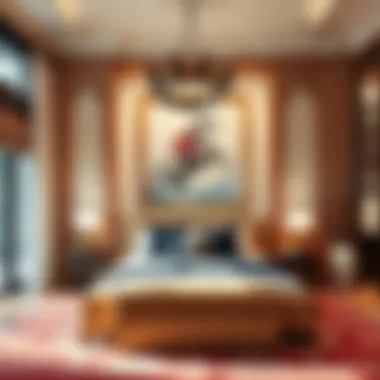

Intro
When it comes to creating the perfect bedroom ambiance, every detail counts. Among these details, large-scale images play a pivotal role, serving not just as decoration but as a statement of personal identity and style. From bold landscapes to abstract designs, the right piece can transform a dull wall into a focal point, breathing life into the space. This guide aims to delve deep into the world of big bedroom pictures, exploring how they can enhance aesthetics and evoke emotions, thereby enriching your sleeping sanctuary.
As we unpack the myriad of styles, themes, and strategic placements, we'll also touch on psychological effects and composition techniques that help make even the smallest of rooms feel inviting and spacious. Whether you are a homeowner aiming for elegance or a renter looking for a splash of color, understanding how to utilize large images effectively will empower you to curate a bedroom that truly reflects who you are. Let's embark on this journey together, discovering how art can be a transformative tool in bedroom design.
Design Inspirations
As we dive into design inspirations, we explore the trending styles and color palettes that can elevate your bedroom's look and feel.
Trending Styles
Large pictures in the bedroom can follow several design trends, reflecting personal taste while also adhering to contemporary styles. Here are some that have been catching eye lately:
- Minimalist: Emphasizing simplicity, minimalist art focuses on basic forms and subdued colors. Think geometric shapes and monochromatic landscapes that create an open, airy feel.
- Bohemian: Rich in vibrant colors and eclectic designs, bohemian art often features nature-inspired subjects or abstract expressions. This style brings warmth and personality, ideal for those who enjoy a more relaxed vibe.
- Industrial: Raw and edgy, industrial artwork often showcases urban landscapes or elements of decay, lending a modern yet rustic feel to your room.
- Scandinavian: Known for its functionality and cleanliness, Scandinavian design incorporates large, bright images that emphasize light and space, often using natural themes and muted tones.
These styles cater to a variety of personality traits and tastes, enabling homeowners and renters alike to infuse their spaces with individuality.
Color Palettes
Selecting the right colors for your large-scale images is essential in ensuring they harmonize with the overall decor.
- Neutral Tones: Colors like beige, gray, and taupe create a subdued backdrop, allowing larger pictures to stand out without overwhelming the space.
- Bold Colors: If your style leans toward the eclectic, consider vibrant pieces in rich reds, blues, or greens. These will serve as focal points, injecting energy into the room.
- Pastels: Soft colors can create a calm and tranquil atmosphere. Images in paler shades provide a serene setting and are especially effective in creating a cohesive look.
- Monochromatic: A single-color palette can add sophistication. Large images in different shades of the same color can create depth without straying from the theme.
Choosing the right color palette not only amplifies the beauty of the artwork but also contributes to the emotional environment of your bedroom.
Large art pieces can dramatically shift the mood in a room. Their impact goes beyond mere decoration; they can shape our perceptions and feelings every time we step inside the space.
Arming yourself with knowledge about trending styles and color schemes will set you on a solid foundation as you select the perfect big pictures for your sanctuary. The right selections will ensure your bedroom not only looks great but also feels uniquely yours.
The Importance of Visual Art in Bedroom Design
When it comes to bedroom design, visual art plays a significant role in defining the overall atmosphere. Much like a conductor guides an orchestra, art can therefore harmonize the various elements of a space, bringing together colors, textures, and themes that may otherwise feel disconnected. It’s not merely decoration; it becomes a key player in creating a sanctuary that reflects personal style while promoting comfort and serenity.
Understanding Aesthetics
To grasp the importance of visual art in bedroom design, one must first appreciate aesthetics—the study of beauty and taste. In this context, aesthetics go beyond mere appearance; it encompasses the emotions and experiences art evokes within a space. Large-scale images, such as striking photographs or abstract pieces, draw the eye and serve as focal points that can dictate the vibe of the room. Art can tell a story, whether through vibrant hues that energize a space or muted tones that evoke calmness and relaxation.
Consider the impact of a large canvas hung above the bed—the first thing one sees upon entering the room. This visual invitation commands attention and sets the emotional tone for the environment. People often find themselves creating very different moods, based on the choices they make in art, from soothing landscapes that encourage restful sleep to dynamic abstracts that inspire creativity.
Psychological Impact of Art
The effects of art extend far beyond the aesthetic. Studies have shown that the presence of visually stimulating elements can positively influence mental well-being. For instance, a serene image of a tranquil forest can reduce stress and anxiety, creating a peaceful retreat away from the chaos of everyday life. On the other hand, bold and bright images can uplift spirits and energize a space, serving as motivation to start the day on a positive note.
"Art is not what you see, but what you make others see." - Edgar Degas
This quote encapsulates the transformative power of artwork in our surroundings. The right piece can provoke thought, inspire a conversation, or simply bring joy. By carefully selecting visual elements, homeowners can enhance their emotional well-being and foster a more engaging and fulfilling environment.
Moreover, art can personalize a space, making it distinctly yours. When you choose a piece that resonates with you, it is more than just a decorative item; it becomes a representation of your identity and experiences. This deeply personal connection encourages individuals to invest in their environments, which subsequently translates into comfort and emotional investment. Thus, the importance of visual art in bedroom design extends far beyond aesthetics; it is foundational to creating spaces that support well-being and highlight individuality.
Types of Big Bedroom Pictures
Choosing the right artwork for your bedroom is a bit like picking the perfect slice of cake; it’s all about personal taste and how well it fits into the overall aesthetic you wish to create. The various types of large-scale pictures can not only bring a sense of personality and style to your space but also serve as a powerful statement piece that ties the whole room together. By understanding the unique characteristics of different types of picture options, you can make informed decisions that elevate your bedroom's atmosphere.
Photography as Wall Art
Large photographs deliver a striking visual impact, making them ideal for any bedroom wall. Unlike paintings or other forms of art, photography captures realism and depth in a way that many find relatable. With subjects ranging from cityscapes to portraits, incorporating photography into your bedroom not only personalizes the space but also expresses your individual interests and experiences.
Imagine a massive black-and-white photograph of a bustling street or a serene landscape stretching across the wall above your bed. This approach can create stunning visual dialogues or simply evoke memories and emotional responses.
- Considerations: Keep in mind the condition of the print and its frame. Opt for quality prints that resist fading over time, especially if they're positioned near windows.
- Benefits: Photography can create depth, is often more budget-friendly, and is easily replaceable if you tire of a particular style or subject matter.
Abstract Art Choices
Abstract art challenges the norm by freeing the viewer from representing reality. It plays with shapes, colors, and forms that often stir various interpretations. Selecting large abstract pieces can infuse your bedroom with contemporary elegance or boldness, depending on the color scheme and style you choose.
- Versatility: Abstract art can easily complement various decor styles. Whether your bedroom leans towards minimalism or maximalism, abstract pieces tend to blend in seamlessly.
- Emotional Connection: The beauty of abstract art lies in its ability to evoke feelings and thoughts that may resonate with you personally. Each viewing can evoke different emotions, making it a dynamic component of your bedroom.
- Sizing: When placing abstract art, think about the color palette in your room. A large piece with vibrant colors can serve as a focal point, while more subdued tones can enhance a calming atmosphere.
Nature-Inspired Imagery
Embodying the tranquility of the outdoors, nature-inspired imagery is an ideal choice for those wanting to bring a sense of calm into their private retreat. Large-scale pictures featuring landscapes, floral imagery, or even close-up details of plants can create a soothing vibe while fostering a connection to the natural world.
- Psychological Benefits: Studies suggest that natural imagery can reduce stress and promote a sense of serenity, adding to the restful nature of your bedroom.
- Breathing Life into Spaces: Since nature embodies diverse colors and forms, these images can align beautifully with different color palettes and styles, creating a cohesive appearance in your room.
- Options: Choose from tranquil beach scenes to rugged mountain landscapes or serene botanical prints, enabling a variety of options tailored to your sensibilities.
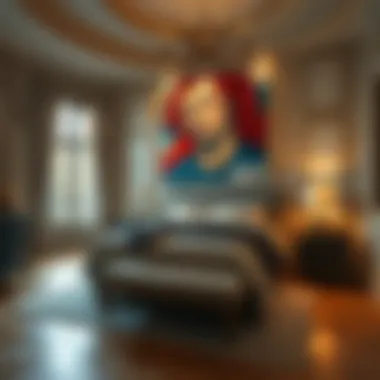
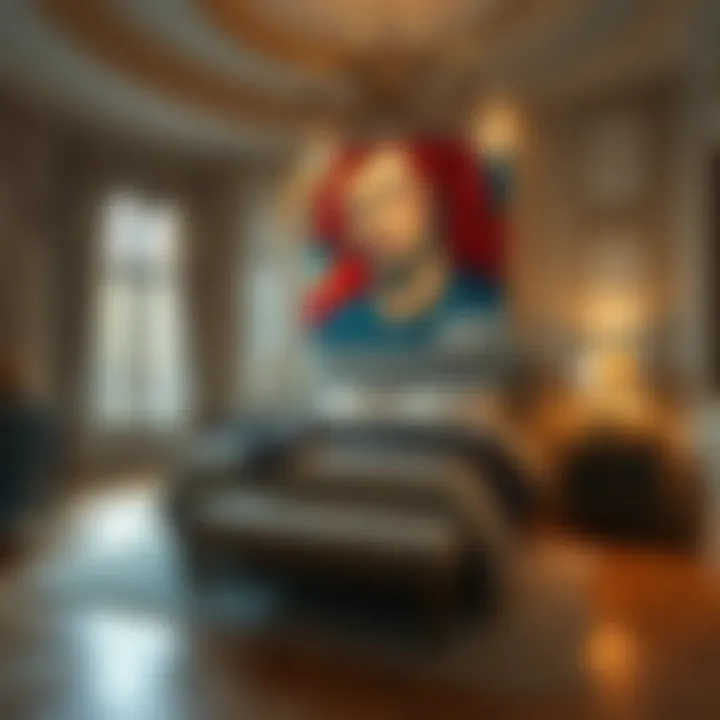
A well-thought-out selection of big pictures not only showcases your aesthetic preferences but also significantly enhances the mood within your bedroom.
Choosing the Right Size
Choosing the right size for artwork in a bedroom is not just a matter of aesthetics; it is a fundamental aspect of creating an atmosphere that resonates with comfort and style. When tackling large pictures for the bedroom, considering both the dimensions of the artwork and the available wall space can greatly affect the overall vibe. An oversized canvas might dominate a small room, creating a sense of claustrophobia, while miniature pieces in a large bedroom may be lost, failing to deliver the impact one seeks. Therefore, achieving the right scale is crucial for an effective visual presentation.
Scaling for Space
Determining the appropriate size of art involves a keen eye for proportions. Start by measuring the wall where you intend to display the artwork. A common guideline is to fill 60% to 75% of the wall space with art to ensure it harmonizes with the surrounding elements. For instance, a 36-inch wide wall could accommodate a piece between 22 and 27 inches in width.
In open spaces, large artwork can serve as a focal point. Conversely, in tightly arranged areas, a smaller piece can prevent overcrowding, allowing other design aspects to shine. It's important to also consider furniture arrangement and height to ensure that the art complements or enhances the existing layout. A taller piece can draw the eye upward, creating the illusion of higher ceilings, while horizontal works can lend width to a narrow space.
"Art is not what you see, but what you make others see." – Edgar Degas
Additionally, incorporating the concept of asymmetry can lead to interesting visual dynamics. For instance, an oversized piece can take center stage above a bed, while smaller pieces flanking it create a well-rounded composition. This approach keeps the eye moving and engaged, facilitating a more dynamic space.
Creating Balance with Size
Achieving balance in a room is akin to walking a tightrope. When arranging large artwork, everything needs to work together like pieces of a puzzle. Scale is vitally important in this process, as it helps to ensure that the art does not compete with other dominant elements in the room. A large picture should harmonize with the size of furniture, including beds, dressers, and nightstands.
One effective method is the use of negative space—the areas around the artwork. Leaving ample room around a large picture creates breathing space and prevents the area from feeling cramped. Combine larger pieces with more delicate elements like small sculptures or plants to create contrast and interest without overcrowding.
Furthermore, consider the height at which you hang your artwork. If the piece is too high, it might feel disconnected from the room. A general rule of thumb suggests hanging art so that the center is approximately 57 inches from the floor, which is often eye level for most people. This ensures that the artwork feels integrated into the space, allowing for a fluid transition between the various elements within the bedroom.
Color and Theme Cohesion
Creating a harmonious environment in a bedroom is more than just placing furniture and choosing wall colors. Color and theme cohesion plays a pivotal role in setting the emotional tone and visual appeal of the space. When large artwork is integrated thoughtfully, it not only enhances the overall design but also promotes relaxation and comfort, key elements for a bedroom.
Different colors evoke varying emotions. For instance, blue tones can instill a sense of calm, while warm hues like red and orange may bring energy. When selecting big bedroom pictures, it’s essential to pay attention to how these colors interact with your existing color palette and overall theme.
Integrating colors from artworks into the bedroom’s scheme can unify the look. When the shades in a picture resemble those in bedding, curtains, or even the walls, they create a sense of flow, allowing the eye to travel seamlessly throughout the room. Considerations like this can transform a routine space into a serene retreat.
Aligning with Bedroom Palette
When it comes to aligning artwork with your bedroom palette, the key is all about coordination rather than matching everything precisely. If your bedroom is dressed in gentle pastels, incorporating a picture that showcases similar tones can enhance the visual story. For example, if the walls are painted soft lavender, a large canvas that holds shades of purple, light green, and white blossoms can resonate beautifully, tying the whole room together.
Selection isn’t just about color; you also have to think about the thriving ambiance the color scheme creates. Use textures and varying intensities to add depth. Here are some tips to achieve that:
- Choose a dominant color: Pick one or two colors from the artwork to emphasize in other decor elements.
- Consider seasonal changes: Swap artwork according to the seasons to shift the mood—warm tones for fall and cooler shades for spring, perhaps.
- Try complementary hues: These can add contrast but still maintain a unified feel; a bright picture against neutral tones can heighten interest.
Creating a Focal Point
Art has a knack for commanding attention, and using it to create a focal point in the bedroom can be particularly powerful. A large piece of artwork can draw the eye immediately upon entry, making it an effective centerpiece for an otherwise simple or minimally decorated room.
To construct this visual anchor, consider placing the artwork above the bed or a prominent piece of furniture, like a dresser. Additionally, avoid overcrowding by selecting other decor that supports rather than competes. Here are some practical approaches:
- Use lighting strategically: A spotlight or track lighting can enhance the art, making it pop even more.
- Balance with symmetry: If you place a singular larger piece, think about balancing it with two smaller items on either side.
- Allow for breathing space: Ensuring there’s enough wall space around the artwork helps emphasize its size and significance without making the area feel cramped.
"A single piece of stunning art can transform an ordinary bedroom into one that tells a story and stimulates the imagination."
In summary, understanding color and theme cohesion alongside effective placement strategies allows for a more curated and expressive personal space. Embracing these principles ensures your big bedroom pictures resonate beautifully within the overall design.
Hanging Techniques
When it comes to art placement in your bedroom, the hanging techniques you choose can make or break the overall aesthetic. Not only does proper hanging enhance the visual appeal, but it also creates a seamless flow within the space, ensuring that your artwork complements the room’s design rather than disrupting it. Beyond mere decoration, the way you position large pictures is a statement about your personal style and taste.
The right hanging techniques not only aid in showcasing your selected pieces but also play a vital role in defining the mood and atmosphere of your bedroom. This planning involves considering various factors from the height of the artwork to the relationship between pieces. As you’ll discover, the manner in which images are displayed can transform an ordinary space into something visually striking.
Eye Level Considerations
One must ponder the question: how high is too high when it comes to hanging art? A good rule of thumb here is to aim for eye level. This varies among individuals, of course, averaging around 57 to 60 inches from the floor to the center of the artwork is frequently recommended. This height not only allows for comfortable viewing but also creates an inviting ambiance in the room.
For example, if your partner is taller, you might opt to raise the artwork slightly. Conversely, if the bedroom is primarily inhabited by children, you may wish to hang art lower. Moreover, large pictures can dominate a space, so it’s essential to keep them in proportion to the furniture and layout. An overzealous high hanging can lead to neck strain or disrupt the visual flow, making it vital to experiment before making any permanent decisions.
Spacing Between Pieces
Spacing is another critical aspect of hanging techniques that can immensely impact the perception of your bedroom. Pay attention to the distance between each piece. Ideally, works of art should be placed 2 to 5 inches apart for a uniform look if you're hanging multiple pictures together. A consistent spacing allows the eyes to travel smoothly between images, creating a harmonious narrative.
However, its important to remember that a crowded wall can lead to chaos, while excessive space can result in a disjointed feel. A balanced approach ensures that each piece of art gets its moment in the spotlight without overshadowing its neighbors.
In summary, the techniques you choose for how to hang your big bedroom pictures are about more than just aesthetics; they encapsulate an entire feeling you wish to convey in your personal sanctuary. It’s all about finding that sweet spot between style, comfort, and emotional connection to the artwork.
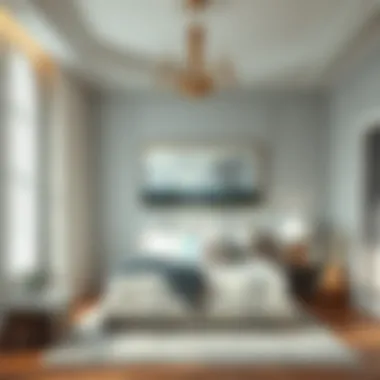
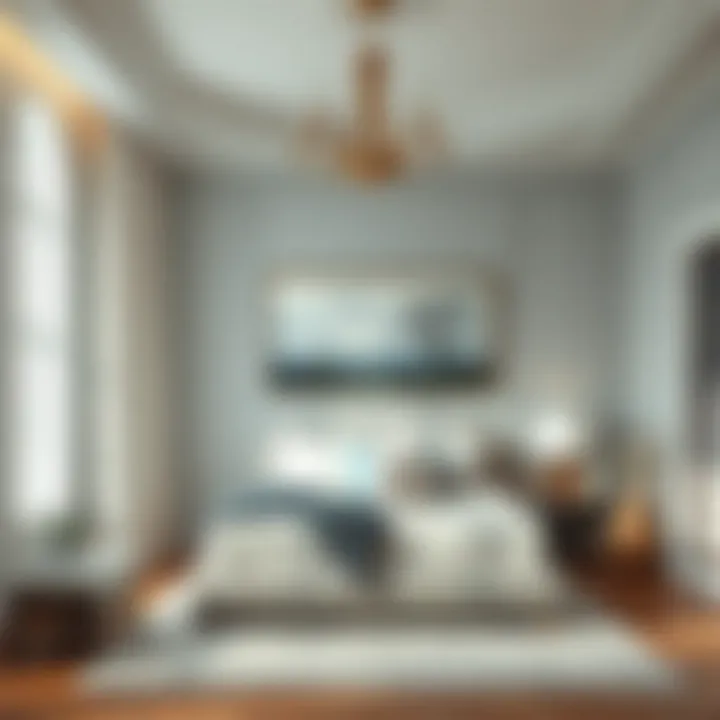
Framing Options
Choosing the right framing options is crucial when it comes to displaying big bedroom pictures. Frames not only enhance the visual appeal of artwork but also protect it from damage, ensuring longevity. A well-chosen frame can accentuate the art’s colors and themes, blending seamlessly with your bedroom's decor while also providing a sense of finished polish. As many homeowners can attest, the right frame can transform a piece from mediocre to magnificent.
Types of Frames
Frames come in a variety of styles, each offering different benefits and aesthetic qualities. It's important to consider both the artwork and your existing decor when selecting a frame. Here are some types that might fit the bill:
- Traditional Frames: These often feature ornate designs and intricate carvings. They’re ideal for classic art styles and can lend an air of elegance to your space.
- Modern Frames: Clean lines and minimalistic designs characterize modern frames. Perfect for contemporary pieces, these frames help maintain a sleek look while allowing the artwork to take center stage.
- Floating Frames: These frames create a shadow effect by suspending the artwork between two pieces of glass or acrylic. They work particularly well with pieces that have texture or with canvases that are unframed.
- Vintage Frames: Often found in thrift shops or flea markets, vintage frames can bring character to your room. They tell a story of their own, adding a unique touch to the overall look.
- Gallery Frames: These types are usually simple, allowing multiple artworks to be displayed together without distraction. It is a common choice for gallery walls, fostering a cohesive art narrative in your bedroom.
Choosing the right frame isn’t just about looks; it’s also about compatibility with the artwork and how it integrates into your overall design concept.
Matting Techniques
Matting plays a significant role in enhancing the presentation of your art. It is essentially a border placed between the artwork and the frame. Here are some considerations for matting:
- Color Coordination: Choose a mat color that complements the dominant tones in the artwork. For example, a soft beige or off-white mat can enhance the colors without competing against them.
- Width Matters: The width of the mat can affect how the piece is perceived. Wider mats tend to create a more formal look, while narrower mats can lend a modern feel.
- Layering Mats: Using double or triple mats in complementary shades can create depth and add visual interest, making the artwork pop.
- Texture Selection: Mats come in various materials; a linen mat, for instance, can add a touch of luxury.
Effective matting elevates your artwork’s overall impact, inviting viewers to appreciate the finer details.
As you can see, the frame and matting selections can significantly enhance your big bedroom pictures. Taking the time to choose wisely ensures your art not only fits beautifully into your space but also speaks volumes about your personal style.
Displaying in Odd Arrangements
When it comes to embellishing a bedroom with art, thinking outside the box can really spice things up. Displaying artwork in odd arrangements is not just a trend; it's a strategy that can breathe life into a space. This method breaks traditional boundaries of symmetry and allows for a playful, individual expression that speaks to personal style.
One of the main benefits of an odd arrangement is that it fosters a sense of spontaneity while still being visually engaging. It can transform an otherwise plain wall into a dynamic canvas. When utilizing odd arrangements, it is essential to consider factors like the size of the artwork, the relation of each piece to one another, and how these decisions align with the overall aesthetic of your bedroom. Here are a few considerations:
- Variety in Size and Shape: Large pieces can serve as focal points, while smaller works can create visual interest around them. Experimenting with varying sizes adds depth.
- Uneven Groupings: Instead of creating a grid pattern, think about clustering pieces in groups that appear to be arranged in unexpected ways. This draws the eye and can prompt conversation.
- Incorporating Depth: Some artworks can be easily layered or placed at different heights, creating a 3D effect that enhances visual intrigue.
"Art is not what you see, but what you make others see." – Edgar Degas
In short, odd arrangements can infuse character into your bedroom and push the boundaries of conventional design. They allow you to tell a story through your chosen pieces, making your space a unique reflection of you.
Gallery Wall Concept
A gallery wall can be an effective layout for showing off your artistic treasures. It’s the perfect way to showcase a collection of artworks, photographs, or memorabilia that resonate with you. The beauty of a gallery wall is that you’re creating a mini-exhibition that can be constantly evolving.
Here’s how to nail the gallery wall concept:
- Start with a Theme: Whether it’s a color scheme, a particular style, or a subject, creating a cohesive theme ties the pieces together.
- Plan Your Layout: Before hammering any nails, lay your pieces on the floor to visualize different configurations. This allows you to shift things around until you find the ideal setup.
- Mix and Match: Don’t shy away from using different frame styles or mixing mediums. The combination of photograph, painting, and even textile art can create a rich visual tapestry.
Mixed Media Displays
Mixed media displays offer a compelling way to add depth and personality to your bedroom walls. This technique merges various forms of artistic expression – such as painting, photography, and sculpture – into one cohesive display.
Engaging with mixed media involves incorporating unconventional elements that may not be typically construed as traditional artwork. For example:
- Textures and Materials: Elements like fabric, metal, or wood can be included alongside paintings and photographs to form a richer experience.
- Use of Space: Mixed media allows the use of shadow boxes to create interest and depth, highlighting not only the art but also its surroundings.
- Personal Elements: Consider including items that represent personal journeys, such as a travel map or collectibles from significant life events.
A mixed media arrangement offers not just visual appeal but also adds sentimental value to your decor, turning your bedroom into a narrative of your life.
Incorporating Textures
When it comes to designing a bedroom, emphasizing textures can truly elevate the aesthetic of the space. While big pictures can capture attention and define a theme, it's often the textured elements that draw people in for a closer look. Textures add depth and interest, making the environment feel cozy and inviting. The tactile experience of art can transform a flat wall into an engaging canvas.
Tactile Elements
Incorporating tactile elements into your bedroom through art offers a unique sensory experience. Think about adding pieces that are not only visually striking but also create an interesting feel. Textured art, such as a woven wall hanging or a canvas with heavy paint strokes, invites interaction. When you touch a textured piece, it ignites curiosity and often evokes memories or emotions.
Benefits of Tactile Elements:
- Enhanced Engagement: Textures can draw the eye in and encourage touch, enriching the way you experience the space.
- Contrasting Surfaces: Mixing materials like fabric, wood, or metals creates a dynamic environment that feels alive and vibrant.
- Personal Connection: Unique textural art often tells a story, making it more relatable and meaningful than flat images.
To implement tactile elements, consider introducing a variety of surfaces in your artwork. For example, a large canvas with bold brush strokes can contrast nicely with a sleek metal sculpture positioned nearby.
Layering Techniques
Layering techniques in art placement is another avenue to enhance texture in your bedroom design. By thoughtfully arranging different pieces, you can create a visually stimulating focal area. The layer concept can transform a standard arrangement into a storytelling backdrop that reflects your personality.
How to Layer Art Effectively:
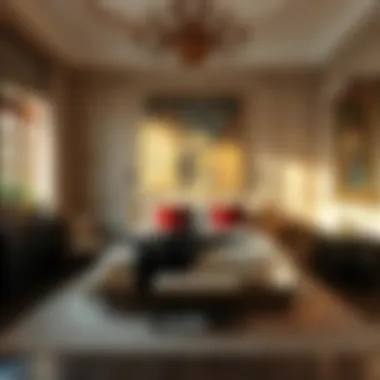
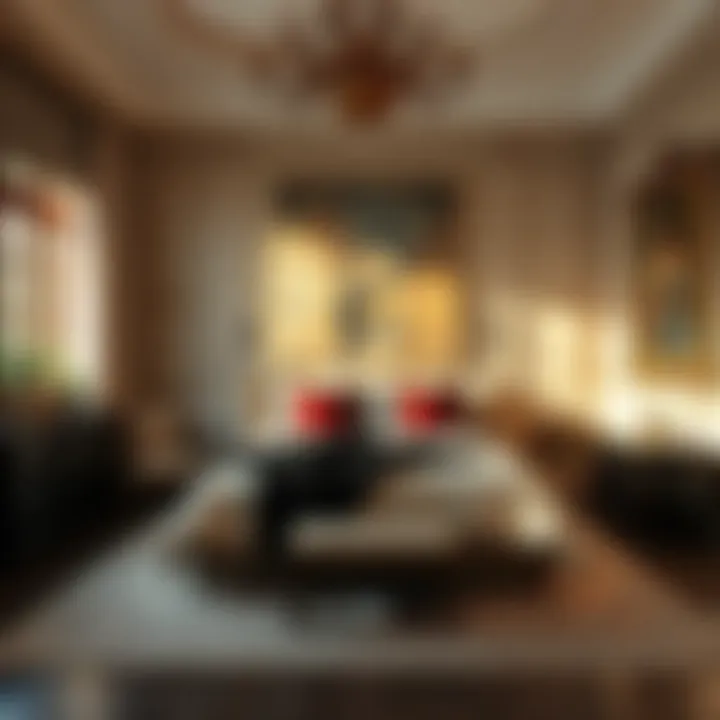
- Vary the Dimensions: Use art of various sizes and shapes to create a comfortable visual balance. A large image can anchor the space, while smaller pieces around it add layers of interest.
- Overlap Pieces: Don’t be afraid to let some art pieces overlap slightly. This approach conveys modernity and creativity.
- Use Frames Wisely: Different styles of frames can add yet another textural layer. Consider mixing wood, metal, and ornate styles within your collection for added depth.
Ultimately, incorporating textures through tactile elements and innovative layering can transform an ordinary bedroom into a rich, intricate space that feels personal and inviting.
"Art is not what you see, but what you make others see." – Edgar Degas
The interplay of texture and imagery confers a level of sophistication to your design choices. By merging these elements effectively, your living space can become a cherished retreat that evokes emotions and sparks joy.
Maintaining and Caring for Artwork
Maintaining and caring for artwork is crucial to ensure longevity and aesthetic appeal in any bedroom setup. Art pieces, especially large ones, are significant investments that reflect personal taste and add depth to the bedroom's ambiance. Proper maintenance not only enhances the artwork's visual impact but also keeps it in prime condition for years to come.
Cleaning Methods
Cleaning your artwork doesn't have to be an overwhelming task. Here are some straightforward methods that you can adopt:
- Dust Regularly: Use a soft, lint-free cloth to gently wipe the surface of the art. Avoid anything abrasive. Dust can dull the colors over time.
- Avoid Water: Unless it's artwork specifically designed to be cleaned this way, steer clear of using water directly on the piece. Water can warp or damage certain materials, like paper or wood.
- Spot Clean: If you see spots or stains, a damp cloth with mild soap can be useful, but test it on a small area first to avoid adverse reactions.
Remember: "An ounce of prevention is worth a pound of cure.” Regular upkeep can save you from extensive damage later on.
Long-term Preservation
Preserving your artwork extends beyond cleaning. Here are some key considerations for ensuring its durability:
- Optimal Environment: Keep the artwork in a stable environment. Extremes of temperature and humidity can warp or ruin fine art. Ideally, aim for a room that's climate-controlled.
- UV Protection: Sunlight can be a silent killer for art. To prevent fading, consider using UV-filtering glass; it helps protect the colors from degrading over time.
- Professional Help: For high-value art, think about consulting specialists for preservation techniques. They offer services like restoration and conservation that can help keep your pieces intact for decades.
For further reading on art preservation techniques, you might find this resource helpful: National Museum of American History
"Art is not freedom from discipline, but disciplined freedom." – John F. Kennedy
Utilizing Technology in Artwork Displays
In today's digital era, technology plays a pivotal role in enhancing how we display and interact with art in our homes. Particularly in bedrooms, where tranquility and personal expression are essential, utilizing technological advances can create an even more inviting environment. This section delves into the modern options available for displaying artwork and the unique benefits they come with.
Digital Frames and Screens
Digital frames have revolutionized the way we think about art displays. No longer are homeowners limited to static images; a digital frame can showcase a rotating gallery of images. Imagine walking into your bedroom and being greeted by a changing tapestry of landscapes, family photos, or abstract art. This flexibility allows for personal tastes to shift over time without needing to invest in new physical pieces.
Key benefits of digital frames include:
- Dynamic Content: Easily update artwork without moving a nail. A simple app on your smartphone can switch out images at a glance.
- Save Space: For smaller bedrooms, digital frames are a fantastic option as they condense a gallery into one sleek device.
- Personalization: Tailor the visual experience to fit moods or even seasons; show calming ocean scenes during summer or cozy montages during winter.
However, one should consider the power source and placement. Positioning your digital frame where it can be plugged in but still have space around it will ensure it doesn't look cluttered.
Virtual Reality Options
Venturing into the future, virtual reality (VR) presents an intriguing avenue for art display. While still in its early adoption phase, the potential for VR in bedroom aesthetics is immense. Homeowners can immerse themselves in art experiences without the need to physically hang anything on their walls. This could be particularly appealing to those with limited space or those who wish to curate an extensive collection of artworks from various styles and periods.
"Art can be experienced in entirely new dimensions with virtual reality, transcending traditional boundaries of visual display."
Here's what to consider with VR for art:
- Interactive Experiences: With software designed to allow for personalization, viewers can walk through a digitally created gallery tailored to their taste.
- Flexibility of Art: Artworks can be reconfigured or resized to suit any room dimension, providing a fluid, customizable experience.
- Collaborative Viewing: Virtual reality allows multiple users to engage in a shared experience, opening up possibilities for discussions about art with friends or family from the comfort of one’s bedroom.
While VR may not yet be mainstream for everyday art viewing, as technology evolves, its integration into home design may soon become a common threads in our lifestyles.
In Summary
The integration of large-scale pictures into bedroom decor plays a pivotal role in shaping the atmosphere of personal spaces. This article highlights the significance of thoughtfully chosen artworks, emphasizing how they enhance not just aesthetics, but also the overall mood of the environment. As bedrooms are often considered sanctuaries for rest and rejuvenation, the vestiges of visual art can transform them from mere sleeping quarters into intimate retreats.
Integrating Art into Personal Spaces
To create a bedroom that reflects one's personality, integrating art becomes a crucial endeavor. Choosing pieces that resonate with feelings and experiences can elevate the emotional resonance of the space. This may involve selecting photographs from cherished moments, abstract pieces that evoke curiosity, or nature-themed artworks that bring a breath of the outdoors in.
Benefits of Art in Bedroom Spaces:
- Personal Expression: Artwork can serve as a mirror, reflecting tastes and stories that define the individual.
- Mood Enhancement: Certain colors and themes can create calming atmospheres, essential for a restful night’s sleep.
- Cohesive Design: When art aligns with the room’s overall theme, it facilitates visual harmony, making the space inviting and comfortable.
However, selecting the right art is not without its considerations. One must think about the size of the pieces, the colors that complement existing palettes, and how the art will be arranged within the space. This careful curation helps in crafting a narrative that is both visually appealing and deeply personal.
Final Thoughts on Big Bedroom Pictures
Art in the bedroom is more than decoration; it's an emotional anchor. A well-placed image can tell stories, evoke memories, or even inspire dreams. As discussed, big pictures serve as focal points that draw attention and spark conversation. In making such choices, consider how these pieces impact your daily life—do they bring joy or calmness?
Art is what you can get away with.
Lastly, always keep in mind the upkeep and preservation of these artworks. The impression they leave can linger for years, shaping thoughts and feelings long after they find their place on the wall. By thoughtfully selecting and arranging big bedroom pictures, one can achieve both aesthetic pleasure and personal resonance in their private haven.



